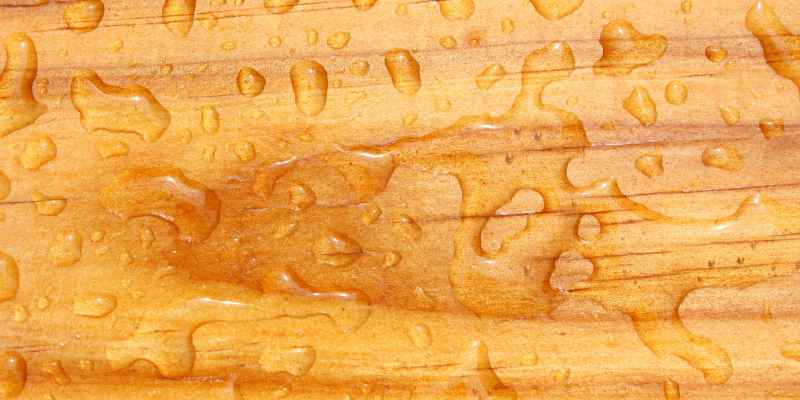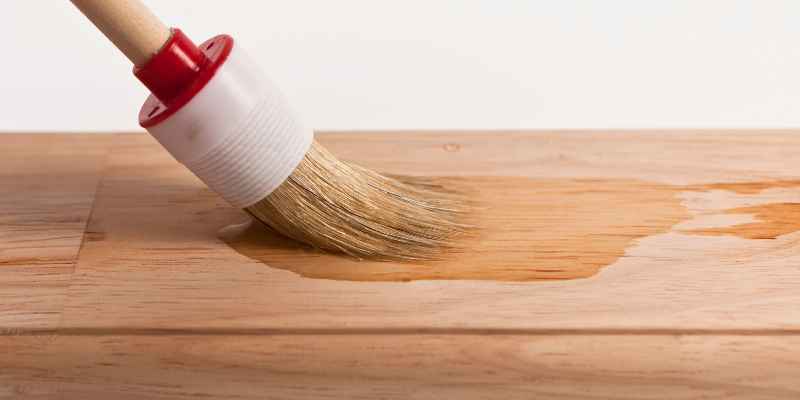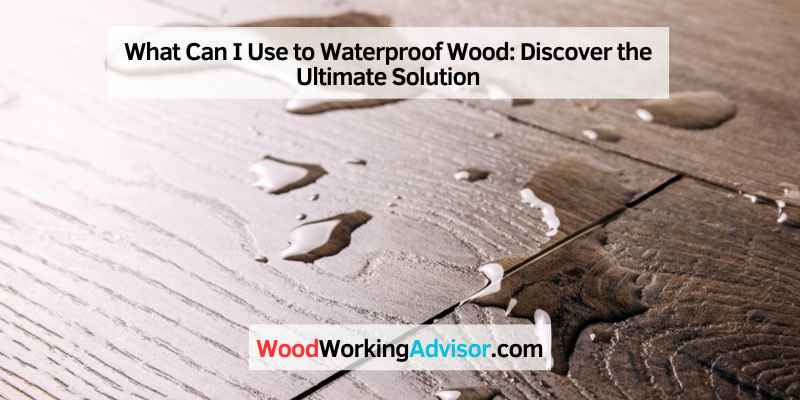To waterproof wood, you can use products such as polyurethane, varnish, or a wood sealer. These materials create a protective barrier and prevent water damage, making your wood resilient to moisture and weather conditions.
They also enhance the wood’s appearance and durability, ensuring it lasts longer and maintains its quality over time. Wood is a versatile and naturally beautiful material used in various applications, from furniture and flooring to outdoor decks and fences. However, it is susceptible to water damage, which can lead to rotting, warping, and overall deterioration.
To protect and extend the lifespan of wood, it is essential to waterproof it. By using products like polyurethane, varnish, or a wood sealer, you can effectively shield the wood from moisture, preventing water penetration and subsequent damage. These waterproofing materials not only provide a protective barrier but also enhance the wood’s natural beauty, ensuring it remains sturdy and durable for years to come. We will explore the different options available to waterproof wood and discuss their benefits.
Types Of Wood Sealers
When it comes to waterproofing wood, there are different types of wood sealers available in the market. Each type of sealer has its own unique characteristics and benefits. Let’s take a closer look at two popular types: oil-based sealers and water-based sealers.
Oil-based Sealers
Oil-based sealers are formulated with oils, solvents, and resins that penetrate deep into the wood to create a protective barrier. They are especially effective for outdoor wood projects such as fences, decks, and furniture, as they provide excellent water repellency and UV resistance.
These sealers are easy to apply, and their oil-based composition enhances the natural beauty of wood by enriching its color and grain. They also offer long-lasting protection against moisture, mildew, and cracking. However, it’s important to note that oil-based sealers can take longer to dry compared to water-based sealers.
Water-based Sealers
Water-based sealers, on the other hand, utilize water as a base instead of oil. They are environmentally friendly, as they contain fewer VOCs (volatile organic compounds) and emit lesser odor during application. These sealers are suitable for both interior and exterior wood surfaces.
Water-based sealers provide a clear finish that does not alter the natural color of wood. They are quick-drying, allowing for faster project completion. These sealers also offer good protection against water damage, UV rays, and fading. However, keep in mind that they may need more frequent reapplication compared to oil-based sealers.
When choosing between oil-based and water-based sealers, consider the specific requirements of your project and the finish you desire. Both types of sealers have their advantages, so it’s important to weigh the pros and cons before making a decision.

Benefits Of Waterproofing Wood
Wood is a versatile and beautiful material that is widely used for various purposes, from furniture and flooring to outdoor structures like decks and fences. However, wood is highly susceptible to moisture damage, which can lead to rot, decay, and a shortened lifespan. By applying a waterproofing solution to wood, you can protect it from moisture and extend its durability. Let’s explore the benefits of waterproofing wood in more detail.
Protection From Moisture
Moisture is one of the biggest enemies of wood. When wood is exposed to water or high humidity levels, it absorbs the moisture, causing it to swell and warp. Over time, this can lead to structural instability and unsightly deformations. Waterproofing wood creates a protective barrier that prevents moisture from seeping into the wood’s surface, effectively reducing the risk of damage. Whether it’s heavy rain, accidental spills, or the natural humidity in the air, waterproofing shields the wood and keeps it looking and performing its best for years to come.
Prevention Of Rot And Decay
One of the most significant benefits of waterproofing wood is its ability to prevent rot and decay. When wood is constantly exposed to moisture, it becomes a breeding ground for mold, fungi, and bacteria, which break down the wood fibers. This can result in the wood becoming weak, brittle, and more prone to cracks and splinters. By applying a waterproofing solution, you create a barrier that repels water and inhibits the growth of these microorganisms, significantly reducing the risk of rot and decay. Waterproofing not only preserves the structural integrity of the wood but also ensures it maintains its aesthetic appeal.
Moreover, waterproofing can also help to protect against UV damage, discoloration, and insect infestation, further prolonging the lifespan of the wood. It is important to note that different types of wood require different waterproofing solutions, so it is essential to research and choose the right product for your specific wood type and intended use. A reputable waterproofing product combined with regular maintenance and re-application can provide long-lasting protection and peace of mind.
Best Practices For Waterproofing Wood
When it comes to waterproofing wood, using the right methods and products is essential to ensure long-lasting protection. Proper waterproofing not only safeguards the wood from moisture, but also extends its lifespan, making it a valuable investment for various outdoor and indoor applications. In this article, we’ll explore the best practices for waterproofing wood, including surface preparation and proper application techniques.
Surface Preparation
Before applying any waterproofing product, it’s crucial to prepare the wood surface properly. This involves thoroughly cleaning the wood to remove any dirt, grease, or previous coatings. Additionally, sanding the surface will smoothen out any rough spots and ensure better adhesion of the waterproofing product. Proper preparation is key to achieving an effective and long-lasting waterproofing result.
Proper Application Techniques
When it comes to applying wood waterproofing products, following the manufacturer’s instructions is crucial for optimal results. Whether you’re using a brush, sprayer, or roller, ensuring even coverage and working with the grain of the wood is important. Additionally, applying multiple thin coats is more effective than one thick coat, as it allows for better penetration and adherence to the wood fibers.
Common Mistakes To Avoid
When it comes to waterproofing wood, there are a few common mistakes that can jeopardize the effectiveness of the process. By avoiding these pitfalls, you can ensure that your wood remains protected from moisture, rot, and other potential damage. Let’s take a look at some of these mistakes and how to steer clear of them.
Skipping Surface Preparation
To achieve optimal waterproofing results, it is crucial not to skip the surface preparation step. Many people underestimate the importance of preparing the wood before applying any sealers or waterproofing products. By neglecting this step, you risk having the waterproofing solution not adhere properly to the wood surface, leading to subpar results and potential issues down the road.
Before waterproofing, it is essential to clean the wood thoroughly. Remove any existing finishes, dirt, grease, and debris. You can use sandpaper to smooth out the surface and create a clean canvas for the sealer to bond with the wood effectively. Remember, a well-prepared surface is the foundation for long-lasting waterproofing.
Using The Wrong Sealer
Another mistake to avoid is using the wrong sealer for the job. Choosing the right sealer is vital for achieving proper waterproofing and protecting the wood from moisture. Different types of wood may require specific sealers to ensure maximum effectiveness. Using the wrong sealer might lead to ineffective waterproofing, resulting in premature degradation and potential damage to the wood.
| Wood Type | Recommended Sealer |
|---|---|
| Pressure-treated wood | Water-based sealers |
| Cedar | Semi-transparent or transparent oil-based sealers |
| Redwood | Penetrating oil-based sealers |
| Teak | Marine-grade sealers |
Ensure you research and choose the appropriate sealer for the type of wood you are working with. Consider factors such as wood species, intended use, and the level of waterproofing required.
Avoiding these common mistakes can help you achieve optimum results when waterproofing wood. By giving proper attention to surface preparation and choosing the right sealer, you can prolong the lifespan of your wood and keep it looking its best for years to come.
Conclusion And Recommendations
When it comes to waterproofing wood, choosing the right sealer is vital for long-lasting protection. There are various options available, each with its advantages and limitations.
Choosing The Right Sealer
A suitable sealer can make a significant difference in preventing water damage and extending the lifespan of your wooden surfaces. Here are some recommendations:
- Waterproofing Paint: Ideal for outdoor wooden structures such as fences and decks, this type of sealer provides a durable protective layer. However, it may alter the natural appearance of the wood.
- Water-repellent Preservatives: These sealers are designed to penetrate the wood and protect it from moisture. They are commonly used for larger wooden structures, like log cabins and exterior furniture.
- Spray Sealers: Perfect for smaller wooden items like crafts or indoor furniture, spray sealers provide a quick and even coating. However, they may require regular reapplications for optimal performance.
Maintenance Tips
To ensure the effectiveness and longevity of the sealer, follow these maintenance tips:
- Clean and Dry: Regularly clean the wood to remove dirt, dust, and grime. Always ensure the surface is completely dry before applying any sealer.
- Inspect and Repair: Periodically inspect the sealed wood for signs of wear or damage. Repair any cracks or chips promptly to prevent water from seeping in.
- Reapplication: Depending on the sealer type and usage, reapply the sealer as recommended by the manufacturer. This will help maintain the protective barrier against water.
By choosing the appropriate sealer and following proper maintenance practices, you can effectively waterproof your wooden surfaces and enhance their durability for years to come.

Frequently Asked Questions On What Can I Use To Waterproof Wood
What Is The Cheapest Way To Waterproof Wood?
The cheapest way to waterproof wood is by using a sealant or waterproofing spray. Apply the product evenly and allow it to dry completely. Reapply as needed to maintain protection. Be mindful of the type of wood and the specific product requirements for best results.
What Is The Best Product To Waterproof Wood?
The best product to waterproof wood is a silicone-based waterproofing sealant. It forms a protective barrier, preventing water damage and extending the lifespan of the wood. Apply a thin, even coat, allowing it to dry completely before applying a second coat if necessary.
How Do You Make Wood Completely Waterproof?
To make wood completely waterproof, apply a waterproofing sealant or a marine-grade finish. Make sure to clean and dry the wood before applying the sealant. Repeat the process as needed to maintain the waterproofing.
How Do You Seal Wood For Outdoors?
To seal wood for outdoors, use a waterproof sealant or wood preservative. Apply multiple coats, following the manufacturer’s instructions. Ensure the wood is dry and clean before applying the sealant. Reapply sealant regularly for long-term protection. Consider using a UV-resistant sealant for added durability.
Conclusion
When it’s time to waterproof wood, there are multiple options suitable for various needs and preferences. Whether it’s using sealants, oils, or varnishes, each method has its own advantages and can be effective in protecting wood from moisture and damage.
By knowing the options available, you can make an informed decision to preserve the beauty and durability of your wooden items.


